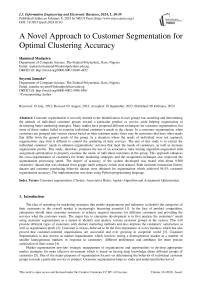A Novel Approach to Customer Segmentation for Optimal Clustering Accuracy
Автор: Hammed Mudasiru, Soyemi Jumoke
Журнал: International Journal of Information Engineering and Electronic Business @ijieeb
Статья в выпуске: 1 vol.16, 2024 года.
Бесплатный доступ
Customer segmentation is not only limited to the identification of user groups but searching and determining the attitude of individual customer groups toward a particular product or service aside helping organization in developing better marketing strategies. Many studies have proposed different techniques for customer segmentation, but some of these studies failed to examine individual customer’s needs in the cluster. In a customer segmentation, when customers are grouped into various cluster based on their common needs, there may be customers that have other needs that differ from the general needs of the group. In a situation where the needs of individual were not captured, organizations may find it difficult to control the rendering of their services. The aim of this study is to extract the individual customer’ needs to enhance organizations’ services that meet the needs of customers, as well as increase organization profits. This study, therefore, proposes the use of an associative rules mining algorithm augmented with assignment optimization to properly examine the needs of individual customers in the group. This approach enhances the cross-segmentation of customers for better marketing strategies and the assignment technique also improved the segmentation processing speed. The degree of accuracy of the system developed was tested with about 9,500 customers’ dataset that was obtained from goggle multi category online store dataset. Both customer transaction history dataset and customer purchasing behavior dataset were obtained for segmentation which achieved 94.5% customer segmentation accuracy. The implementation was done using Python programming language.
Customer segmentation, Clusters, Associative Rules, Apriori Algorithm and Assignment Optimization
Короткий адрес: https://sciup.org/15018899
IDR: 15018899 | DOI: 10.5815/ijieeb.2024.01.03
Текст научной статьи A Novel Approach to Customer Segmentation for Optimal Clustering Accuracy
Published Online on February 8, 2024 by MECS Press
The idea of searching for marketing strategies that enable organizations and industries to identify the categories of their customers in the overall market is increasingly becoming essential [1]. In the face of product competition, enterprises should mine customer resources to achieve targeted measures for different customers and providing the services what the customer wants. The major key to enterprise development is to first analyze the customers’ needs using customer segmentation as a means to identify and analyze various customer groups in the system. This will provide different types of customers with distinct marketing methods and also improve the customers’ satisfaction as well as organization profit [2]. Customer is always believed to be the first importance of every business which has also proved that customer-oriented organizations are successful and ever growing in cooperate world [3]. Customer Segmentation is also known as market segmentation which involves seeing a heterogeneous market as a number of smaller homogeneous markets in response to customers’ different preferences and attributes for more precise satisfaction of their wants [4].
Market segmentation provides strategic management of organizations and opportunities to develop appropriate market strategies for more effective investment which is based on having deep knowledge about different groups of customers [5]. One of the major purposes of segmentation focuses on determining the behavior of individual customer groups towards a particular service or product. Customer segmentation helps to study and understand behaviors of customers which is actually done by analyzing different types of information about customers which will ensure customer satisfaction and optimal profit [4].
This will enable firms or organizations to control the rendering of their services following the current feedback from potential market users or consumers to develop new market strategies [6].
Market segmentation is also an act of dividing customers into distinct groups based on their needs, characteristics, and behavior which enables the firms to develop differential marketing strategies following their characteristics, needs, and behavior. Customers are divided into different groups based on specific criteria or attributes. In a behavioral segmentation, market users or consumers are grouped based on their behavior [7]. Customers differ in personality and have various preferences. There is evidence that inequalities in marketing exists. As a result, having the same approach and marketing for every consumer may not be effective [8].
In market segmentation, communication with the customers to incorporate their needs is one of the tools to increase the profits of organizations. The increase in organizations’ profit is achieved when organizations’ services are rendered according to the needs of customers [9]. However, one of the challenges for all firms or organizations is that they can't connect to all customers at large in diverse markets. This prompts every firm or organization to focus on customers within their capacity using the customer relationship method. The highest positive marketing is the inherent nature of all marketing strategies and market segmentation is the tool for achieving it [10]. According to customer segmentation theory, clusters of customers with the same demands and similar purchasing behavior hopefully respond to marketing trends constantly [11]. Market segmentation is an important aspect of modern marketing, enterprises organize particular goods and services for each target customer group which will create relationships with customers [12]. Through segmentation, firms and organizations get to know their customers better and use the knowledge to improve the customers' services, reduce operating costs and increase their profits [13]. However, the division of customers into groups has shown to be an information network for promoting deals and vital arrangements in market settings. In cloud computing environment, there are individual customers who have similar requests, and their usage exemplar may have common characteristics [14]. The study further argued that only good customer segmentation can leads to a potential business strategy.
Customer segmentation has been proposed by different studies in different areas such as telecommunication companies, Cloud computing, and also in the area of e-commerce. Among the studies that proposed customer segmentation in telecommunication are: [15, 16, 17] while [18] proposed customer segmentation in cloud computing. Other studies proposed customer segmentation in e-commerce, the studies include: [19].
Data Mining is generally known as a tool that allows the extraction of every element of sensitive data and information within the data [20]. Although different studies have proposed different techniques to classify customers into different segments for better marketing strategies, many market institutions failed to adopt customer segmentation as a marketing strategy. This is due to the fact that techniques proposed by most of the studies examined did not propose methods that are scalable for large marketing purposes especially marketing organizations that deal with larger (global) customers. Moreover, clustering algorithms used by some of the existing studies failed to employ a crossclassification method that checks various clusters if there are differences regarding product usage, demographics, and other characteristics.
This study discovered that some of the studies that used supervised learning clustering such as the decision tree algorithm can only identify structures in a set of data, and they also use only a variable to cluster. While other studies that used unsupervised learning clustering such as k-means suffer from misrepresentation of data and difficulty in determining k which is the determinant of computational speed. However, the major objective of this research is to extract the groups that share the similar needs as well as those who have other needs aside the general needs of the groups. This will enhance organizations’ services that meet the needs of customers, and also increases organization profits. Having an accurate customer segmentation will update the organization knowledge about the products that having huge patronage require more concentration of both human and material resources instead of wasting resources on products that attract low patronage. Even though, products that attract low patronage can also be rebranded to meet the customers’ satisfaction or organization introducing incentive rewards to best customers for the products with low patronage. This will encourage the customers to change their purchasing attitude. Therefore, this study used a hybrid approach, associative rules mining (Apriori) algorithm augmented with assignment optimization to proper segment customers into common needs as a group and further cross examined the individual needs in each group. Individual differences in each group were properly captured through customers’ purchasing behavior and their transaction history. The assignment optimization technique enhanced Apriori algorithm for accurate and faster segmentation of customers into their favorite needs.
The rest of the study is organized as follows. In Section 2, the methodology was discussed in detail as the customers were clustered into various groups based on their purchasing attitudes. In Section 3, the details discussion of the results was represented with tables and figures. t he conclusions were drawn in section 4 .
2. Methodology
The method used in this study consists of two techniques which include association rules (Apriori algorithm) that find relationship among the customers to select them into various right group and the assignment method which optimize the Apriori for accurate customer segmentation. The association rule mining uses If-THEN as a measure to quantify the support and confidence of the rule to find the relationship among the customers. The recognized measures used to assess association rules are the support and the confidence of a rule. Both are computed from the support of certain item sets as it is shown in algorithm 1.
Algorithm 1: Association Rule Mining
Step 1: I = { i , i ,... i } – set of items;
s tep 2: D = set of transactions; each transaction t is included in i;
s tep 3: X = set of items from i, t contains X .
s tep 4: a n association rule is a pair X → Y , where X ⊆ I , Y ⊆ I , X ∩ Y = φ ;.
s tep 5: c onfidence of the rule X → Y is c, if c% of the transactions in d that contain the set x, also contain the set Y.
s tep 6: s upport of rule X → Y is s, if s% of the transactions in d contains the set X ∪ Y .
The Apriori algorithm establishes the association of specific customer by considering its purchasing behavior and transaction history to reveal the matching customer profile and identify the right groups. Apriori algorithm is an item set mining which can fetch data using subsets of subsets from large transactional databases. It proceeds by identifying the frequent individual items in the database and extending them to larger item sets as long as those item sets appear sufficiently often in the database.
The algorithm generates rules for frequent customers’ needs from groups with its support and confidence measures. X and Y are expressions that are formed from the association rule where X and Y are disjoint needs of customers in each group. The algorithm generates frequent customer needs from a set of customers with an associative rule. t herefore , when a set of customer groups ( x , x ,..., x ) were merged with the set of customers’ needs ( y , y ,..., y ) , this will segment customers into different groups based on common needs of each group. That is associative rules mining segments set of customers into groups based on their common needs and assigning the needs of individual customer in each group. This will ensure that both common needs of each group and individual needs aside the common needs were captured. That is, Apriori algorithm segments customers having common needs in a group with minimal support and use these common needs to generate interesting rules and continue to segment the customers in each group based on their needs until individual needs of customers are also captured. The algorithm delivers by characteristic the foremost frequent individual needs within a group to create another group and continue to create customers’ groups as long as individual needs can be found in the groups. The algorithm continue the process until no more individual needs can be found and no more groups can be created, the system process is shown in system pseudocode.
System Pseudocode
Step 1: Identify the customers’ needs and generates a set of customers as a group
Step 2: Creates rules to find an efficient association.
Step 3: Generate sub-groups from customers’ groups
Step 4: Continue to generate sub-group until no more sub-group
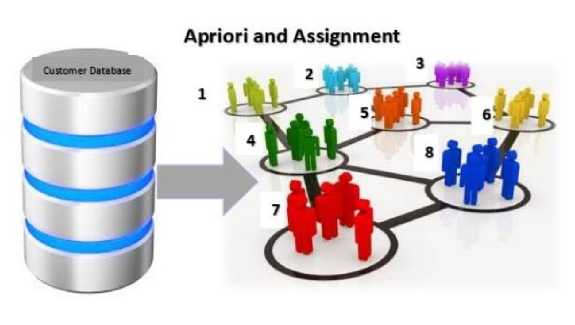
Fig. 1. Customer Segmentation Proce
The system discovered sets of frequent customers’ needs in the groups and the association rules were generated on a set of transaction customers’ data. The algorithm first identified the common needs of each group and also identified the needs of individual from common needs of each group and extends the process to the large groups of customers until the resulting needs reach a specified number of supports. The architecture of the system was designed to depict the customer segmentation process as it is shown in Figure 1 and the system method which shown the logical flow of information in the system is represented with fig 2.
Customer dataset
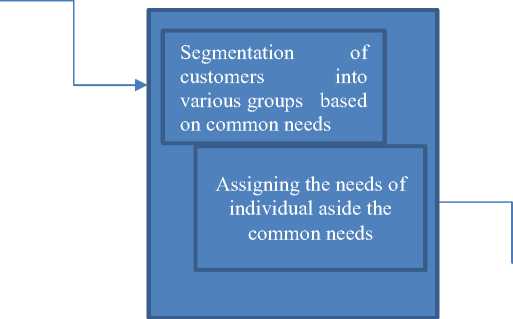
Customer segmentation
Fig. 2. System Architecture
The study used the assignment method to properly classify the needs of each customer to one and only one customer so that the differences in other characteristics and purchasing behavior of customers can also be properly segmented. Assignment method is a particular case of a transportation problem where the given resources are allocated to an equal number of activities with the aim of optimizing the given objective.
The assignment optimization techniques enhanced the selection of customers into various groups based on their common needs as well as individual needs. This was made on a one-to-one basis using the assignment data matrix in Table 1. The grouping of the customers into different segments with different purchasing behavior of individuals formed standard customer segmentation as it is shown in Table 1.
Table 1. Assignment Data Matrix
|
Customer groups |
Different needs of individual customers |
|||
|
x 1 |
y 11 |
y 12 |
y 13 . . . |
y 1 n |
|
x . |
y 21 . |
y 22 . |
y 23 . . . . . |
y 2 n . |
|
. xn |
. yn 1 |
. yn 2 |
. . yn 3 . . . |
. ynn |
The proposed system used decision variables to model the assignment of attitude i to customer j s in each group such that:
J 1 If attitude i is assigned to customer j and 0 for otherwise 0
The variable represents each customer's attitude to be 1 and 0. Where 1 indicates that attitude is assigned to a customer but 0 indicates that the attitude is not assigned to a customer. The assignment technique that was used in the study examined the cross-classification of customers with different purchasing attributes. The standard assignment method is defined in equations 1, 2, 3, and 4, the equation determines the number of groups that achieved crosssegmentation.
nn
Minimize Z= YY y j x j (1)
i = 1 j = 1
Subject to the constraints
n
^ Ху = 1, for all i (group available)(2)
j = 1
n
^ Ху = 1, for all j (attitude requirement)(3)
i =1
and Ху = 0 or 1, for all i and j(4)
The assignment technique clearly distinguishes various purchasing characteristics of individual customers in each group. Customers' expressive behaviors may include customer transaction history, purchasing behavior, product-related needs, and specific brand-related organizations and selections in a cross-segmentation using assignment optimizatio
3. Result and Discussion
The dataset in table 2 was also obtained from Google online store, the event type column in the table was captured to segment the customers into different groups based on their event type (purchasing behavior).
Table 2. Customers’ Purchasing Behavior
|
Sum of |
Sum of |
Sum of |
|||||
|
brand |
category_id |
Year |
Month |
event_type |
price |
product_id |
user_id |
|
airnails |
1.49E+18 |
2020 |
February |
view |
$3.81 |
11357305 |
1.22E+09 |
|
bluesky |
1.49E+18 |
2020 |
February |
cart |
$2.38 |
5864107 |
6.09E+08 |
|
bluesky |
1.49E+18 |
2020 |
February |
purchase |
$3.97 |
5804604 |
2.78E+08 |
|
bpw.style |
1.49E+18 |
2020 |
February |
view |
$0.79 |
5906122 |
5.67E+08 |
|
bpw.style |
2.06E+18 |
2020 |
February |
cart |
$3.18 |
11729473 |
7.43E+08 |
|
cnd |
1.49E+18 |
2020 |
February |
view |
$14.13 |
5804277 |
5.66E+08 |
|
concept |
1.49E+18 |
2020 |
February |
view |
$16.97 |
17128314 |
1.7E+09 |
|
cosmoprofi |
1.78E+18 |
2020 |
February |
cart |
$6.35 |
5868795 |
5.66E+08 |
|
cosmoprofi |
1.78E+18 |
2020 |
February |
view |
$14.29 |
11737939 |
1.17E+09 |
-
1 x = purchaser'event_type*]
-
2 у = purchaser1 Sum of user_id']
pit.xlabeK1 Event Type', fontsize=14)
A pit. ylabeK'User ID', fontsize=14)
-
5 plt.barh(x, y)
-
6 plt.showO
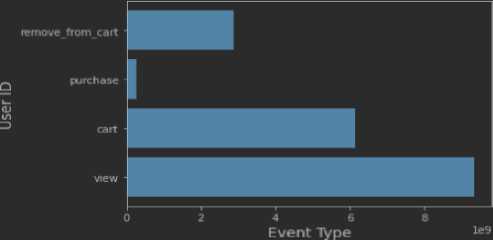
ODO Ф Python Console О Problems И Terminal О Services ago) Scanning files to index... ^^^^^^^^^^^^^^^^^^ || Show all (2) LF UTF-8 4 spaces ■._________CT Z «I_____________________________A ID x do) Fig. 3. Segmentation of Customers Based on Purchasing Behavior The segmentation of customers into different clusters (groups) was implemented with python programming language as it is shown in fig 3. The customers were selected into different groups based on their event type (purchasing behavior) which include view, cart purchase and remove from cart. The customers’ purchasing behavior was used to form different groups and customers were selected into groups. It was observed that customers with view purchasing behavior has highest number of customers, this is a vital information that can enhance organizations’ services following the current feedback from potential market users. The dataset in fig 4 was obtained from goggle multi category online store, the dataset are in 2 categories which includes customers’ transaction history and customers’ purchasing behavior. The dataset was first cleaned using PBI software and formatted into csv format which was imported with python language using pandas method. The customers’ transaction history dataset was used to capture different product brand where the system was able to matched customer product brand and identify the right groups. Fig. 4. Goggle multi category online store dataset for Customer Transaction History It was observed that many customers prefer a specific brand color after being segmented into the right groups. The segmentation of customers into preferred brand color was done after being grouped based on their preferred products as it is shown in fig 5, 6 and 7. Fig. 5. Different Customer Groups with Red Color Brand Fig. 6. Different Customer Groups with White Color Brand Fig. 7. Different Customer Groups with Yellow Color Brand Accurate segmentation of customers into different groups enables organizations’ services to be rendered according to the needs of customers and also to develop new market strategies. After the selection of different customers into different groups based on particular characteristics and needs, the assignment of different needs of each customer was cross classified with the assignment technique. Each group of segmentation attributes was identified when assignment optimization was implemented with QM for Windows software as in Table 3. QM for windows provides mathematical analysis for operations management, quantitative methods, or management science. In the implementation of assigning needs to an individual customer, 6 groups of customers were used with 6 different attributes, and both rows and columns of the table were examined one by one to determine the differences in the customers’ needs. The QM for windows was used for implementation of assignment method which generated table 3 and 4. Table 3. Assigning the Needs of Individual Customer Assignment of needs to individual customer solution Optimal solution value=0 Atnibute1 Atnibute2 Atnibute3 Atnibute4 Atnibute5 Atnibute6 Group 1 1 Assign 0 1 0 0 1 Group 2 1 0 1 Assign 0 1 1 Group 3 Assign 0 1 0 1 0 1 Group 4 1 1 Assign 0 1 1 0 Group 5 1 1 1 1 1 Assign 0 Group 6 1 0 1 0 Assign 0 1 Since the number of assignments is equal to the number of rows or columns, the assignment solution is optimal. The goal of assignment method used is that asides the general characteristics of each cluster, the assignment method allocated individual needs in the cluster. This ensured that needs of individual in the cluster are well captured for proper clustering. The pattern of assignment among the groups and individual customers in the group with their respective needs is shown in Table 4. In the table, six different attributes and six clusters were used and it was observed in the attributes that there is zero, one and two, it is indicated that there some customers with zero attribute which shows that the customers with zero attribute do not have other needs except the general needs attributed to the particular group which they are belong to. In the table there are some customers with 1 attribute, this shows that customers with 1 attribute have one need aside the general needs associated with the particular group that formed their cluster. Where there is 2 attribute in the table, this indicates that customers with 2 attributes have two other needs aside the general needs that grouped them together. Table 4. Result of Assignment method for Individual customer Assignment of needs to individual customer solution Atnibute1 Atnibute2 Atnibute3 Atnibute4 Atnibute5 Atnibute6 Group 1 0 0 1 Group 2 0 0 0 1 1 Group 3 2 2 1 2 Group 4 1 2 2 2 1 Group 5 0 1 1 1 Group 6 0 0 0 1 The associative rules mining algorithm have better performance in customer segmentation compared to some of other clustering algorithms such as k-means which some of the existing studies have used. K-means has been chosen among all clustering algorithms for customer segmentation implementation which considered as most popular one of its types. K-means needs to determine the value of k which may be difficult to determine and misrepresentation of data which can lead into inaccuracy of the customer segmentation implementation. Many studies that used associative rules mining failed to examine individual needs in a particular group. Finding the individual needs in a particular group is relevant point when studying customer segmentation. Apriori algorithm augmented with assignment optimization brought about a high degree of 94.5% clustering accuracy in examining needs of individual customer in each cluster or group. The system found the relationship among the groups of customers using associative rule mining and used assignment method to properly find the needs of individual in each cluster which might differ from general needs of that particular group. The study analyzed the groups that share the similar needs as well as those who have other needs aside the general needs of the group. This helps organizations to identify and focus on the products that have highest demand to the least demand. The system in this study plays important role in improving the business and provides service satisfaction for the customers. Thus, the system has better performance compared to many existing clustering algorithms. It is important to have high degree accuracy of customer segmentation which will enhance organization services and increase their profits. Accurate customer segmentation updates organization about their products that needed to be rebranded to meet the customers’ needs. The organization can also use the strategies of rewarding their customers for a particular product with low patronage to attract and encourage more customers. More resources can be concentrated on products with high patronage and also offer special discounts to encourage regular customers to increase their monetary value. This will encourage customers to maintain their purchasing attitude which will attract more profits for organizations and firms. Although, there is a limitation for system clustering accuracy comparison because some of the existing system failed to propose techniques for cross-classification of individual customers. Many existing results were just focused on the time taken the system to cluster the customers into groups.
4. Conclusion The literature revealed that customer segmentation is an important aspect of modern marketing. This study used the Apriori algorithm augmented with assignment optimization which is a tool to properly examine the needs of individual customers in each group. Although customers may be grouped into different clusters based on their common needs but cross-classification of individual customers’ needs gives vivid information about the needs of individual customer which will enhance response to marketing trends. Having an accurate segmentation will be helpful to predict marketing strategies and it is also enabled the organizations to control the rendering of their services following the current feedback from potential market users. This research work helps to identify the needs of individual in the clusters for accurate customer segmentation and without accurate segmentation organizations cannot succeed in customers’ products satisfaction. The assignment optimization techniques used also improved the rate at which the Apriori algorithm segmented the customers into various groups. While all unnecessary processing that may occur when the algorithm is searching and selecting customers into a particular group was drastically reduced. The system quite achieved high degree of accuracy.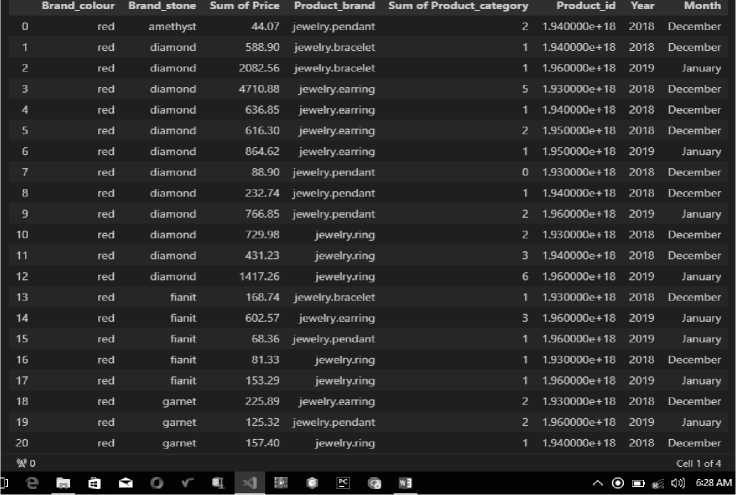
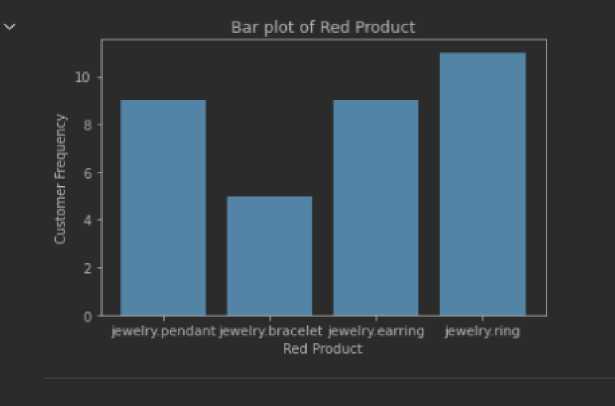
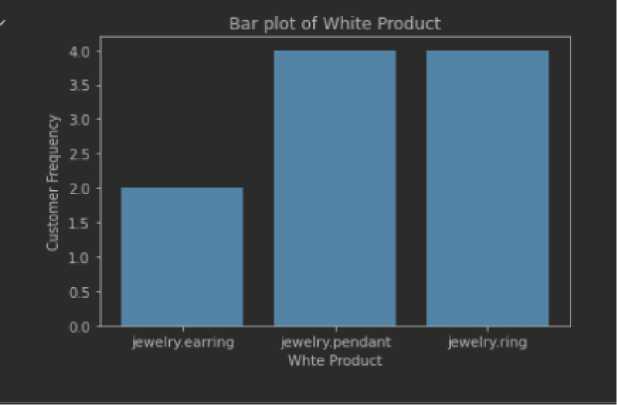
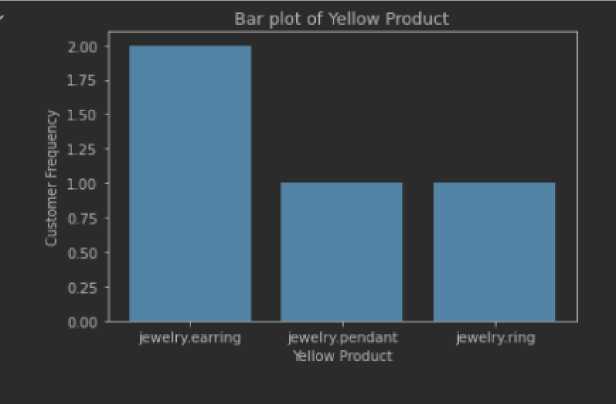
Список литературы A Novel Approach to Customer Segmentation for Optimal Clustering Accuracy
- G. Martin, “The Importance of Marketing Segmentation”. American Journal of Business Education (AJBE), vol. 4, No. 6, pp. 15-18, 2011.
- P. Monil, P. Darshan, R. Jecky, C. Vimarsh, and B. R. Bhatt, “Customer Segmentation using Machine Learning”, International Journal for Research in Applied Science & Engineering Technology (IJRASET), vol. 8, no. 6, pp. 2104-2108, 2020
- B. K. Vishakha, “Customer Visit Segmentation Based on Clustering and Association Rules”, (Doctoral dissertation, Dublin, National College of Ireland), 2020.
- A. S. M. Hossain, “Customer Segmentation using Centroid Based and Density Based Clustering Algorithms” In 2017 3rd International Conference on Electrical Information and Communication Technology (EICT), pp. 1-6. IEEE, 2017.
- G. Mladenova, “Bank Customers’ Segmentation: Problems and Marketing Solutions”. Burgas Free University, Burgas in Bulgarian, 2015.
- P. Gamble, A. Tapp, A., Marsella, and M. Stone, M., “Marketing Revolution: The Radical New Approach to Transforming the Business, the Brand and the Bottom Line” Journal of Direct, Data and Digital Marketing Practice Vol. 7, no. 4, pp. 371-372, 2006.
- T. Konstantinos and C. Antonios, “Data Mining Techniques in CRM Inside Customer Segmentation”. A John Wiley and Sons, Ltd., Publication, 2009.
- T. Kayalvily, V. Shubashini and R. Vinayakumar, “K-Means Clustering Approach for Intelligent Customer Segmentation Using Customer Purchase Behavior Data”, Sustainability, vol.14, no. 12, pp. 243, 2020.
- N. Juni, E.N. Lukito, F. Ridi, and I.S. Paulus, “Review on Customer Segmentation Technique on E-commerce”. Advanced Science Letters, Vol. 22, no. 10, pp. 3018-3022, 2016.
- G. Sulekha, G., “The basis of market segmentation: a critical review of the literature”. European Journal of Business and Management, vol. 3, no. 9, pp. 45-54, 2011.
- F. Buttle and S. Maklan, S., “Customer relationship management: concepts and technologies. Routledge, 2019.
- A.E. Giddel, “Customer Behavior Segmentation among the Mobile Service Providers using Algorithms. (Comparison of K-means and Self-Organizing Maps)”. Masters- Dissertation, 2021.
- D. Frankel, S., Heck and H. Tai, “Using a Consumer-Segmentation Approach to Make Energy-Efficiency Gains in the Residential Market”. McKinsey & Company, Chicago, IL, USA. Nov:1-9, 2013.
- W. Caesar, R. Kotagiri and B. Rajkumar, “Cloud Computing Market Segmentation”. In ICSOFT, pp. 922-931. 2018.
- B. Judy, “Customer segmentation in the telecommunications industry”. Journal of Database Marketing &Customer Strategy Management, vol.17, no 3 / 4, pp.247 – 256, 2010.
- H. Chengrong, S.., Huaying and Q. Xinchun, “Customer Segmentation Model Research Based on Organizational Customer Life Cycle in Telecom Operator”. International Conference on Education Technology and Social Science (ICETSS 2014), pp. 408-414, 2014.
- Exacaster, “Prepaid Customer Segmentation in Telecommunications”, 2013. Retrieved on 3rd July 2023 from www.exacaster.com
- H. Jianhui and M.A. Dan, “The Pricing Model of Cloud Computing Services” In Proceedings of the 14th Annual International Conference on Electronic Commerce, (pp. 263-269), 2012.
- A. Bashar, A., Fadi, and B.M. Mohamed, “The implementation Trends of Intelligence E-CRM in Business process”. In 4th IEEE International Colloquium on Information Science and Technology (CiSt), (pp. 35-39). IEEE, 2016.
- S. Jesus, V., Noel, B.L., Luz Adriana and H.R.M. Rafael, “Association Rules Extraction for Customer Segmentation in the SMEs Sector Using the Apriori Algorithm”, Procedia Computer Science, Jan 1;151:1207-12, 2019.

